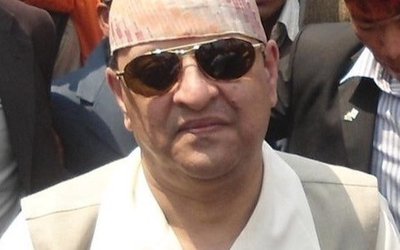More on Opinion






A famous aphorism of Nietzsche advises: Battle not with monsters, lest ye become a monster, and if you gaze into the abyss, the abyss gazes also into you. The much-hyped Hattiban retreat earlier this week failed to produce, leave alone an elephant, even a measly mouse of a direction ahead. Now Nepal’s ruling oligarchy must be finding the abyss staring back into the emptiness of their leadership bereft souls. The abyss is also staring into the hearts and minds of their EuroAmerican and Mughlani underwriters, leaving the former to pull back on their fund disbursing largesse and the latter to engage in more headless adventurism through disreputable interlocutors.
The political adventurism of 2005/2006 has produced the sad finale of keeping this venial Baburam-Madhesi warlord dispensation barely alive in a political ICU. It cannot be allowed a dignified death since it is too late, with barely over a month left for the self-extended CA term to end, to go for fruitless rounds of elections for a new prime minister. The Kangress and the EhMaLeys thus find themselves in a “no options trap” as rubber-stamp bystanders. A new peoples’ constitution cannot be drafted under existing constitutional provisions without mangling them and essentially bypassing the Nepali people. The hairy issues of federalism, power balance therein, and the overall governance framework have become even more hairy and intractable. The devious manner in which secularism and republicanism were foisted on the country is seeing the emergence of new resentments, their frightening implications for Nepali politics in the days ahead being among the trolls emerging from the abyss. A new mandate is required from the people as the one given in 2008 ran out two years ago, but no leader left or right has any idea how to bring about new elections, for what and under what arrangements (baring those who argue for going back to the 1990 constitution to at least hold legitimate elections for a democratic dispensation).
A professor of mine used to admonish students about badly designed scientific experiments by saying: if you don’t know where you are going, any road will take you there. It applies sadly even more aptly to the Loktantrick experiment carried out on Nepal, which has seen a series of ad hoc improvisations, agreements and betrayals since the 12-point Delhi compromise in November 2005. The first to be betrayed was the king and now it has been the turn of the Maoist guerillas in the cantonments. One hears of rationalizations that it is only appropriate to marginalize these two extreme fringes; but that argument would hold only if the so-called center was sound and the fringes not eating into the innards. The so-called political mainstream is not in a healthy state, and the failure at Hattiban is only one more symptom that it is visionless and bereft of any moral high ground. Indeed Prachanda, Sushil Koirala and Madhav Nepal, judging from their recent ranting about the alliance of royalists and Maoist hardliners, seem to be troubled by nightmares of a crab-like pincer of nationalists and those seeking social justice emerging from the abyss.
Even the president of this “republic-in-making” had to step in, as he has in the past in the Army chief’s unwarranted dismissal case, to warn that he will not put his signature on a constitution that will lead to the country’s disintegration or balkanization. Criticism against him for this statement, which Loktantrick hardliners see as “anti-federalist”, has been rather mute compared to the previous instance with Gen. Katuwal because it reflects a majority sentiment against half-baked federalism. And there is no intellectual fire, or the time anymore, to bake anything rock solid on federalism, because no party has any idea what it really means for Nepal’s governance. Furthermore, this admonishing is merely the carrying out of normal head-of-state duties, by president or king, no matter how ceremonial. The bigger irony is that the neo-feudal heads of big political parties could not stand a constitutional king exercising Article 127 that the parties themselves had asked him to exercise when they themselves failed to go for elections, and decided to replace him with a ceremonial president and a CA fully empowered to exercise full sovereignty. Ironically, what the people find they now have instead is a CA that merely rubber-stamps decisions of three or at best half a dozen party oligarchs and a president that the parliamentary parties themselves need to have step forward to maintain order if the political world as we know it should end on May 28th. It is another instance of the abyss staring back, an abysmal situation brought about by betrayal of agreements, gentlemanly as well as multi-pointed, and the lack of political foresight.
The 10th April betrayal of the Maoist fighters by their own leadership that ordered the sudden army capture of Maoist cantonments will have more serious consequences in the days ahead. It lifts the lid off a can of worms of half-truths, propaganda and outright falsehoods that has been the mainstay of Loktantra. And how the angry Maoist fighters as well as the parliamentary parties that had been porters to the Maoist agenda so far deal with them will determine the course of the political circus in the pre- and post May 28 deadline. Stepping back to list some of them (with help from what has appeared in the political weeklies) may give a feel for the terrain, and the manner in which the Maoist establishment will seek to counter the parliamentary parties as well as its own hardliners.
As the Shaktikhor tape indicated, there never were nineteen thousand fighters but only about five thousand. The number was inflated by Prachanda on advice from Girija Koirala who needed to scare the RNA into docility, and UNMIN’s Ian Martin obliged. About two-thirds of the real Maoist fighters became YCL storm troopers, extorting and arm twisting so that the Maoists emerged as the largest party in the CA. The remaining fifteen or so thousand in the camps were new recruits and part-timers who received full ideological and military training in the camps these half-dozen years at state expense. More than eighty to ninety percent of them, including the most hard-core fighters, will remain outside of sequestration in the newly-created (and disarmed) “forest and factory guards’ directorate”. They will be, as security analyst Rajendra Thapa Bhuimanchhe writes, match-sticks scattered over 4000 VDCs, ready recruits for new political violence. Furthermore, with the best arms not in UNMIN containers but “swept away by rivers” to quote Prachanda – again, as reported, on advice of Girija Koirala – and subsequently partly sold to armed Tarai groups and also Indian Maoists, they have the potential to fuel new violence. A frightening abyss stares back.
Why did Prachanda and Baburam conduct such a coup against their own? Some inkling can be had if one reads Trotsky’s Russian Revolution: as doctrinaire Leninists, they need to hang on to power post-May, and only an alliance with the Nepal Army will help in that, even if it means sacrificing their own. In the disorder that will ensue with a constitution disliked and burned by many or without one, it will be the “soviets of workers and soldiers’ deputies” backing Baburam’s provisional government that will call the shots. Unless, of course, the abyss stares back and frightens the rest into sense.





